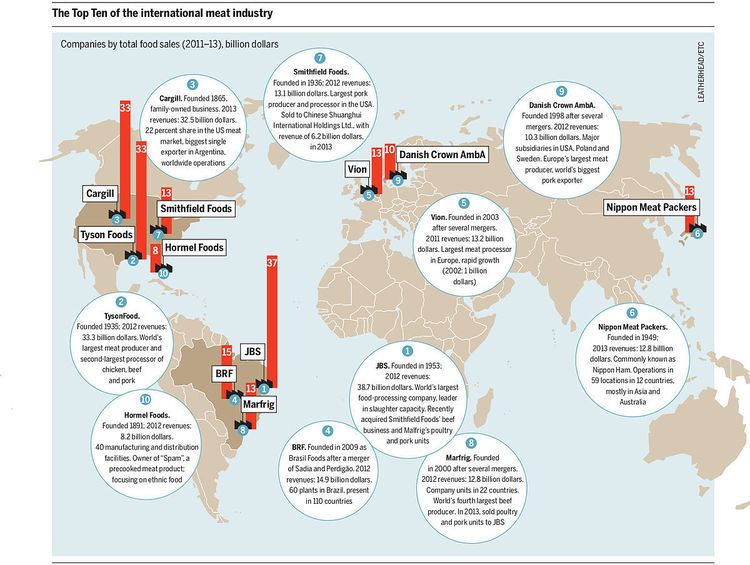 | ||
The term meat industry describes modern industrialized livestock agriculture for production, packing, preservation and marketing of meat (in contrast to dairy products, wool, etc.). In economics, it is a fusion of primary (agriculture) and secondary (industry) activity and hard to characterize strictly in terms of either one alone. The greater part of the entire meat industry is termed meat packing industry- the segment that handles the slaughtering, processing, packaging, and distribution of animals such as cattle, pigs, sheep and other livestock.
Contents
A great portion of the ever-growing meat branch in the food industry involves intensive animal farming in which livestock are kept almost entirely indoors or in restricted outdoor settings like pens.
Many aspects of the raising of animals for meat have become industrialized, even many practices more associated with smaller family farms, e.g. gourmet foods such as foie gras.
The production of livestock is a heavily vertically integrated industry where the majority of supply chain stages is integrated and owned by one company.
Efficiency considerations
The livestock industry not only uses more land than any other human activity; it's also one of the largest contributors to water pollution and a huge source of greenhouse gas emissions. In this respect, a relevant factor is the produced species' feed conversion efficiency. Additionally taking into account other factors like use of energy, pesticides, land, and nonrenewable resources, beef, lamb, goat, and bison as resources of red meat show the worst efficiency; poultry and eggs come out best.
Companies
Among the largest meat producers worldwide are:
Criticism
Critical aspects of the effects of industrial meat production include
Many observers suggest that the expense of dealing with the above are grossly undercounted in present economic metrics and that true/full cost accounting would drastically raise the price of industrial meat.
Possible alternatives
Cultured meat potentially offers some advantages in terms of efficiency of resource use and animal welfare. It is, however, still at an early stage of development and its advantages are still contested.
Increasing health care costs for an aging baby boom population suffering from obesity and other food-related diseases, concerns about obesity in children have spurred new ideas about healthy nutrition with less emphasis on meat.
Native wild species like deer and bison in North America would be cheaper and potentially have less impact on the environment. The combination of more wild game meat options and higher costs for natural capital affected by the meat industry could be a building block towards a more sustainable livestock agriculture. A growing trend towards vegetarian or vegan diets and the Slow Food movement are indicators of a changing consumer conscience in western countries. Producers on the other hand have reacted to consumer concerns by slowly shifting towards ecological or organic farming.
